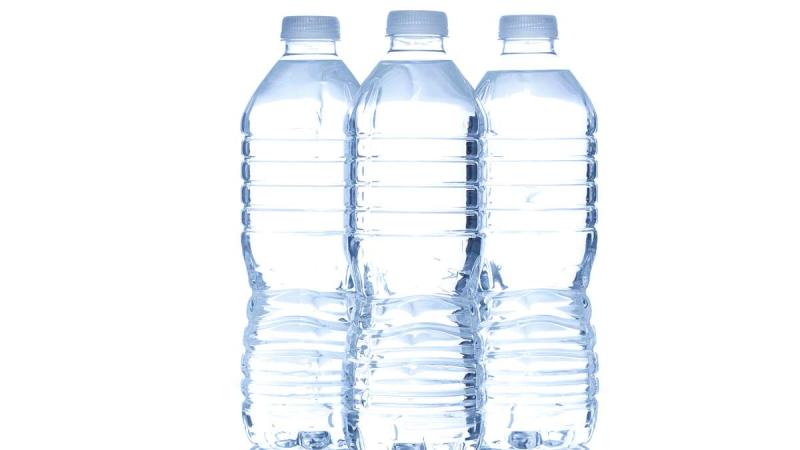The truth about nanoplastics in bottled water | UCLA Health
By: UCLAHealth


Forewarned is Forearmed.

There's no doubt that water is one of the healthiest drinks around. It's essential for keeping you hydrated without adding any calories, sugar or other additives to your diet.
Americans have obviously gotten the message about water consumption. In 2022, American consumers purchased nearly 16 billion gallons of bottled water — at a cost of $46 billion.
While drinking all that water is great, buying it in plastic bottles comes with a few unwanted problems. Too many of those bottles end up in oceans and landfills, leading to pollution. And new research shows they are also leading to consumption of tiny plastic particles.
What are nanoplastics?
As the name implies, nanoplastics are extremely tiny pieces of plastic. They are many times smaller than a speck of dust and cannot be seen with the naked eye.
Nanoplastics can leach into liquids (like water) stored in single-use plastic bottles. They can also find their way into bottled water during the manufacturing process.
How many nanoplastic particles are in bottled water?
It's been no secret for years now that nanoplastics are lurking in bottled water and in products packaged or wrapped in other kinds of plastic. But new research has called attention to just how big an issue these particles may be.
A study published in January 2024 used new methods to analyze just how many nanoplastic particles really are floating around in the average plastic bottle of water. They found that a liter of bottled water can contain as many as 240,000 tiny plastic fragments. That number is 10 to 100 times more than previous estimates.
Those findings have raised new concerns about whether bottled water is safe to drink.
Are nanoplastics harmful to our health?
Ingesting hundreds of thousands of microscopic bits of plastic doesn't sound very appetizing. And nanoplastics might be nearly invisible, but that doesn't necessarily mean they are completely harmless.
So far, research on the possible health impacts of consuming nanoplastics has yielded mixed results. But there is some evidence that they may be negatively affecting our health. Studies conducted on animals and on cells in a lab suggest nanoplastics can impact a variety of organs and systems throughout the body. Exposure to high quantities of nanoplastics may affect cell's immune function and cause inflammation.
There is even some evidence that by altering cell function, nanoplastics may increase the risk of some types of cancer. It's important to note, however, that very little research to date has looked specifically at humans.
4 steps you can take to avoid nanoplastics
Exposure to nanoplastics (and their slightly larger cousins, microplastics) is nearly unavoidable in today's world. So many of our foods and beverages come in plastic containers, get wrapped in plastic and are carried in plastic shopping bags.
Limiting the amount of single-use plastic in your life is important for more than your health. Skipping plastic bottles and bags is better for the environment: Between 4 and 12 million metric tons of plastic end up in the oceans each year. Those bottles and bags collect in the ocean and on the beaches where they harm fish, birds and other wildlife.
Limit your use of single-use plastics by:
- Investing in a good-quality reusable bottle (glass or stainless steel are best) and filling it with filtered tap water
- Bringing your own reusable bags — including ones you can use for produce — when you go to the grocery store
- Buying soaps and other cleaning products in refillable containers
- Reusing plastic food containers for storing other items whenever possible
Every time you avoid purchasing something in a single-use plastic bottle, bag or container, you're helping the environment — and you're helping yourself by limiting the nanoplastic particles you take into your body.
Do Stay On Topic!
Do Add Something Substantive or Be Gone.
No personal or ad hominem attacks, spamming, or advertisements.
No Trolling.
No Mocking Others. (Your comment may be removed without additional warning.]





NOTE: I am excited to share this article with URGENCY and look to discussing safety for our bodies and our minds. That being said, I am curious as to who is sponsoring this information that is being put out to the public .
To learn more about nanoplastics in bottled water, reach out to your primary care physician
High levels of nanoplastics in plastic water bottles, new study finds (usatoday.com)
35 seconds inside the video posted to your comment this statement is made:
I, too, probably like many of us, wondered about hot or 'melting' plastics around heat (e.g., microwave containers declared 'safe' BUT very hot when food is heated), but just assumed our the professionals were on it. . . . Now, part of me feels betrayed. . . inspite of it all. In any case, better we know for sure now rather than not at all.
BTW, yes! Babies are going to be dealing with plastics in their bodies too given them by their adoring, loving parents and family members.
Uh-oh! I think we are in 'trouble'! The image is likely of micro-plastics . . . nano-plastics are nearly invisible to the naked eye.
I've read about this previously-- its not a hoax, its very real.
It was so relatively 'good' the first time, it bears 'reprint.' Also, there is a movie trivia question (you are a 'buff'?) which, though from a time long gone now, asked the quintessential question. I wonder if you know where this phrase hails:
Also, there is a movie trivia question (you are a 'buff'?) which, though from a time long gone now, asked the quintessential question. I wonder if you know where this phrase hails:
Is it Safe?
Society-at-Large (world-wide) is probably overusing plastics. . .:
THE QUESTION:
Should this plastics 'crisis' turns out to be a "CRISIS" of national importance,
will our NEXT NEW leader in the WHITE HOUSE be a science 'Do-er'
seeking a real-world policy solution to overuse (abuse) of plastics, or a
science 'Loser' denying science its proper diagnosis and real-world policy correction?
I see no end to the use of plastics. What would replace them? I gave up worrying about insignificant stuff that has no obvious effect or viable solution years ago. Any efforts to mitigate this alleged problem would simply make everything more expensive for everyone
Artilce pull-out:
“It’s important not to scare the hell out of people, because the science in this space is still evolving, and nobody in the year 2024 is going to live without plastic,” said Landrigan, who was not involved with the preprint.
But do try to minimize your exposure to the plastic that you can avoid, such as plastic bags and bottles.”
Using glass is too inconvenient to stay alive longer?
Some think that is the sole purpose of this web site.
Trumpists are 'enlisted' to wage political warfare against their fellow Americans. They 'come' to marginalize, minimize, lie, 'down-size' the truth, be contrary, mock, diminish, and confuse. That is, trumpists are 'plying' their minds for the chaos and division they have been DEPLOYED to spread on the internet. I will call it as I see it!
Government, at the end of the day, has let 'us' down with plastics pervasive across the country and by extension the world—intentionally or unintentionally. On the other-hand, those who downplay the problem of plastics destroying our 'make-up' as humanity. . .are guilty of rhetoric which aids and abets the furthering of "insanities" in our bodies and even incremental death!
Glass. New 'creations.' More durable plastics. . . . Who can say.
I remember long ago watching a video that I can no longer find a 'full version' of to post here. Check it a 'shortened' version: "A Grave Theat."
A Grave Threat I Cosmos: A Spacetime Odyssey
Some of us may see no end to plastics. . . but this video (above) hones in on LEAD/POISONING as a culprit affecting humankind en masse. Today, we have removed lead from society (above ground in public and private spaces - largely). Enjoy the shortened clip!
Good question!
In terms of human histoory, the use of plastics is fiarly recent.
So I was wondering-- what did we use (instead of plastics) all those years?
(Or. all those . . . all those Centuries...?)
Earth Day 2024: What Did People Use Before Plastic?